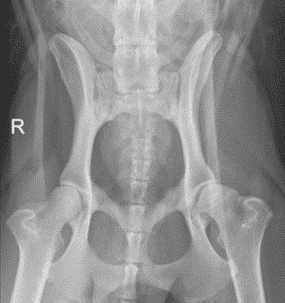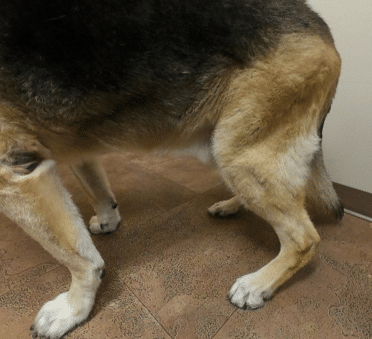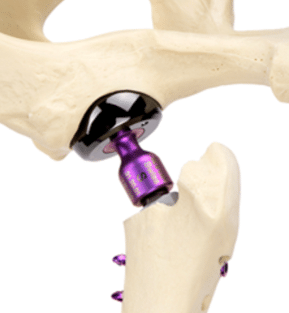About Hip Dysplasia
Hip dysplasia, meaning abnormal growth of the hip, is a common problem in dogs. One in three dogs suffer from Canine Hip Dysplasia (CHD).
A normal hip is a tightly-joined “ball and socket” joint. The normal hip joint enables the hind leg to move smoothly in a full range of motion and allows a dog to rise, walk, run, jump, and turn effectively. In the diseased hip, the “ball and socket” become irregular, rough, and deformed, causing pain and decreased range of motion.
The irregular nature of the joint will contribute to the development of osteoarthritis (OA). Symptoms of OA include joint pain, tenderness, stiffness, locking, swelling, limping, or reluctance to rise, walk, or sit.

The radiograph shows the shallow acetabulum (more pronounced on the left hip) and irregularities to the femoral head (mild hip dysplasia).

Dogs with chronic joint disorders still wag their tails and participate in normal activities, and owners frequently fail to register the subtle signs of constant pain. Dogs with hip dysplasia are often described as “lazy,” but inactivity, especially in young dogs, is often a consequence of chronic pain and discomfort.
Because dogs walk on four limbs, they can compensate for this pain by shifting weight to their front limbs. This adaptation can result in compensation injuries in the elbow and shoulder.
Sedation will be necessary for complete pre-surgical radiographs.
What surgeries are recommended?
For mature patients, Femoral Head Ostectomy (FHO) and Total Hip Replacement (THR) surgeries can be indicated.
FHO involves the removal of the ball portion of the “ball and socket” hip joint. The head of the femur is removed and, in time, scar and soft tissues fill the joint space and the muscles around the hip develop and compensate for the lack of a hip joint. This will eliminate a great deal of the pain associated with CHD, but it will not maintain the normal function of the hip. For this reason, FHO is generally not recommended for large breed patients.
Total Hip Replacement (THR) surgery replaces a painful and dysfunctional hip joint with an artificial prosthesis, in order to provide a pain-free, fully functional joint. Total hip replacement can also be considered for a dog with a painful and abnormal hip due to fracture, luxation, or necrosis of the femoral head. The THR prosthesis replaces both the ball and socket. There are a variety of THR implants on the market.
THR’s are very expensive and have a high revision rate of about 30%. Of those revisions, over 90% of them are due to complications with the cup. If a normal THR with a cup fails, then a surgeon can use a “cupless” implant for revision.
At Advanced Veterinary Care, we prefer to use a “cupless” system. By eliminating the cup, we significantly decrease the complication rate as well as the cost to the owner. Healing time for either is about 12 weeks.

Pictured: A Cupless Hip Replacement Implant